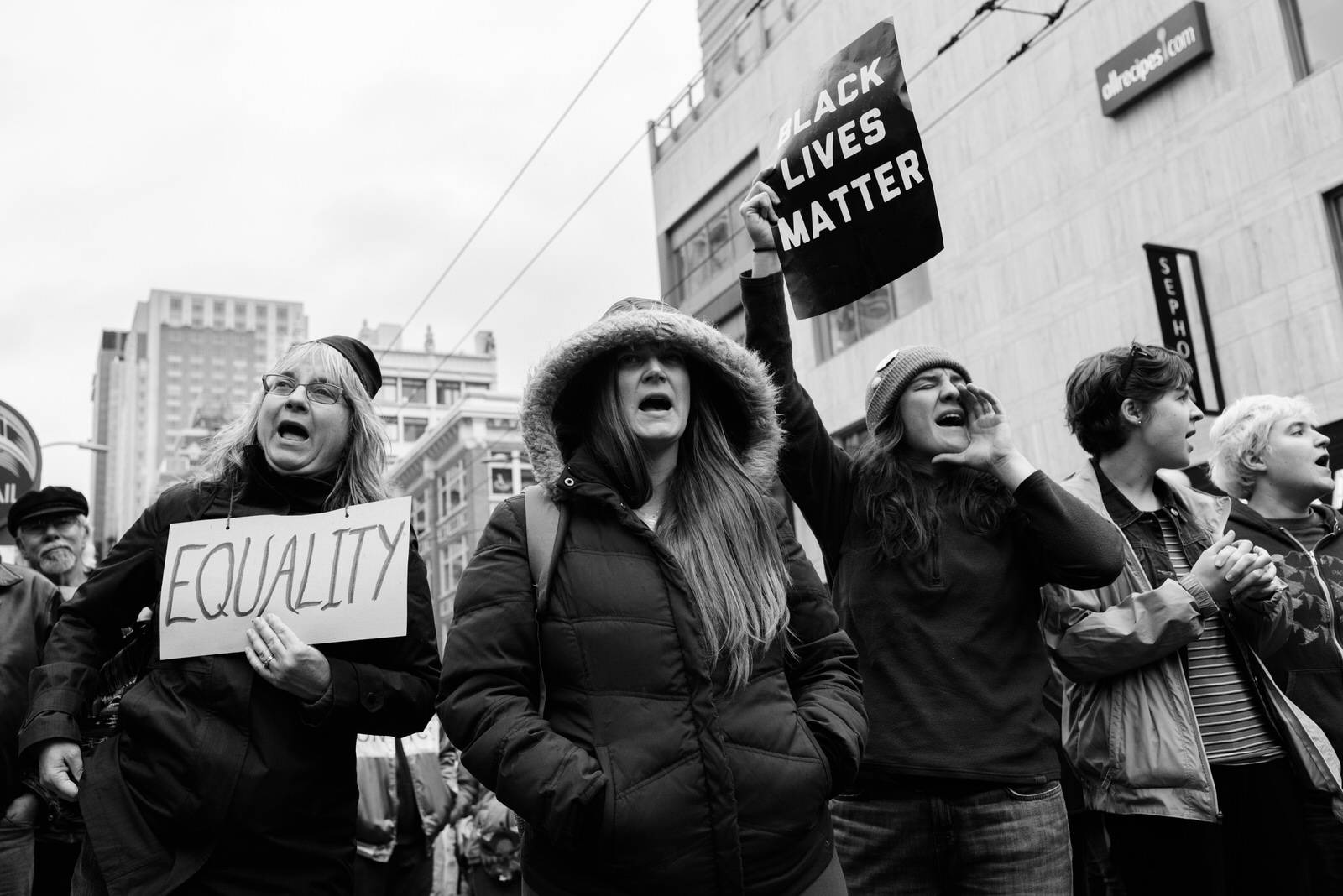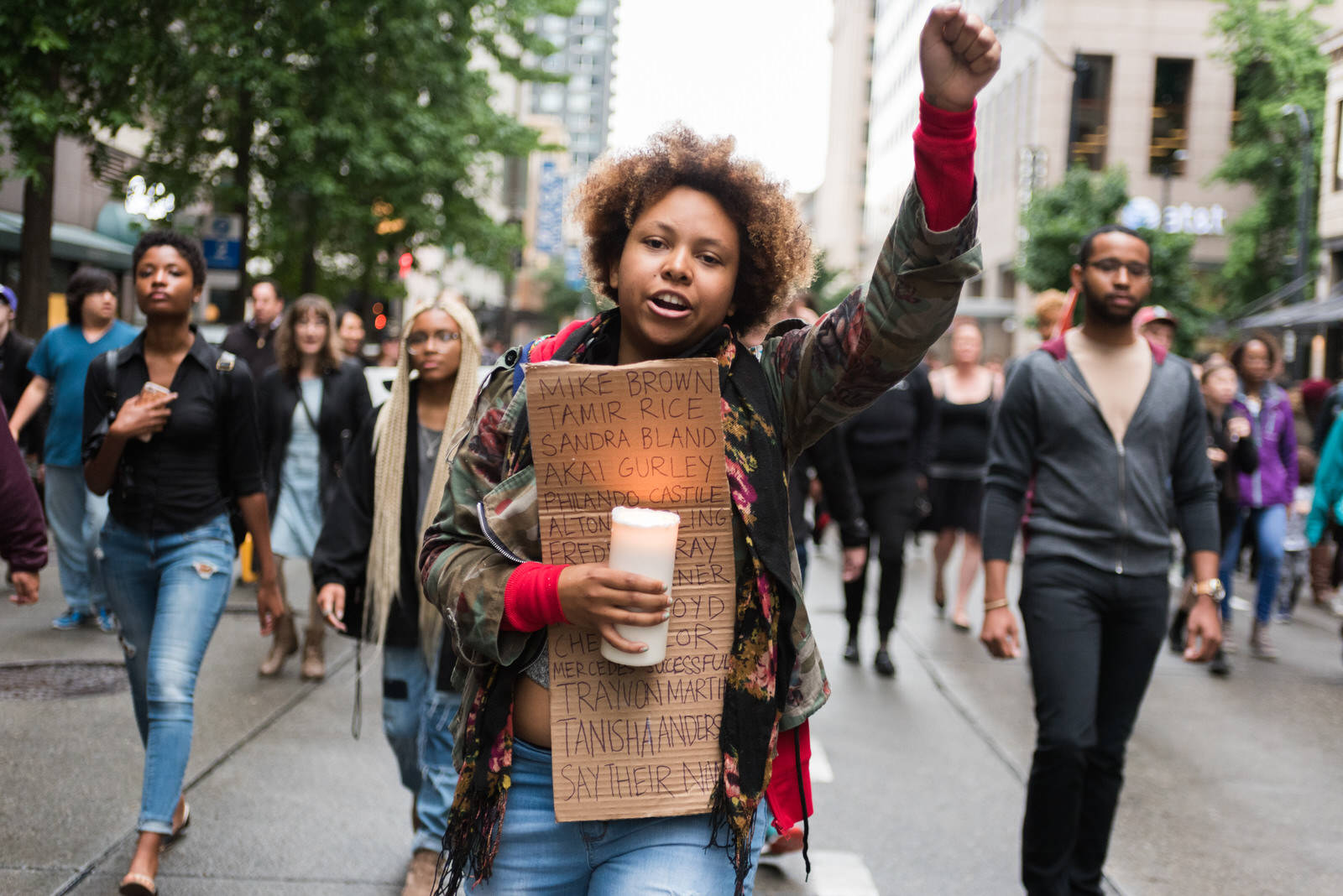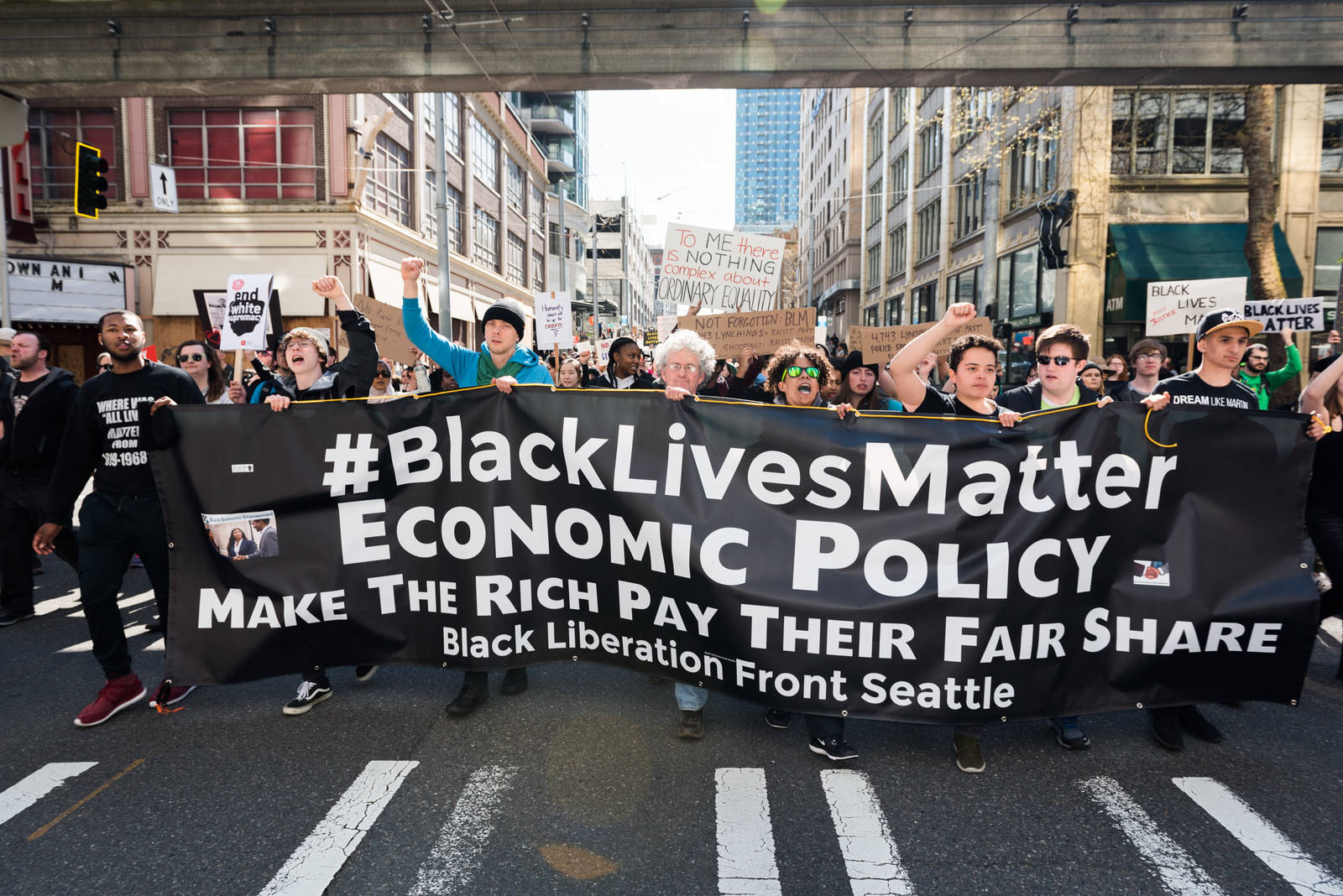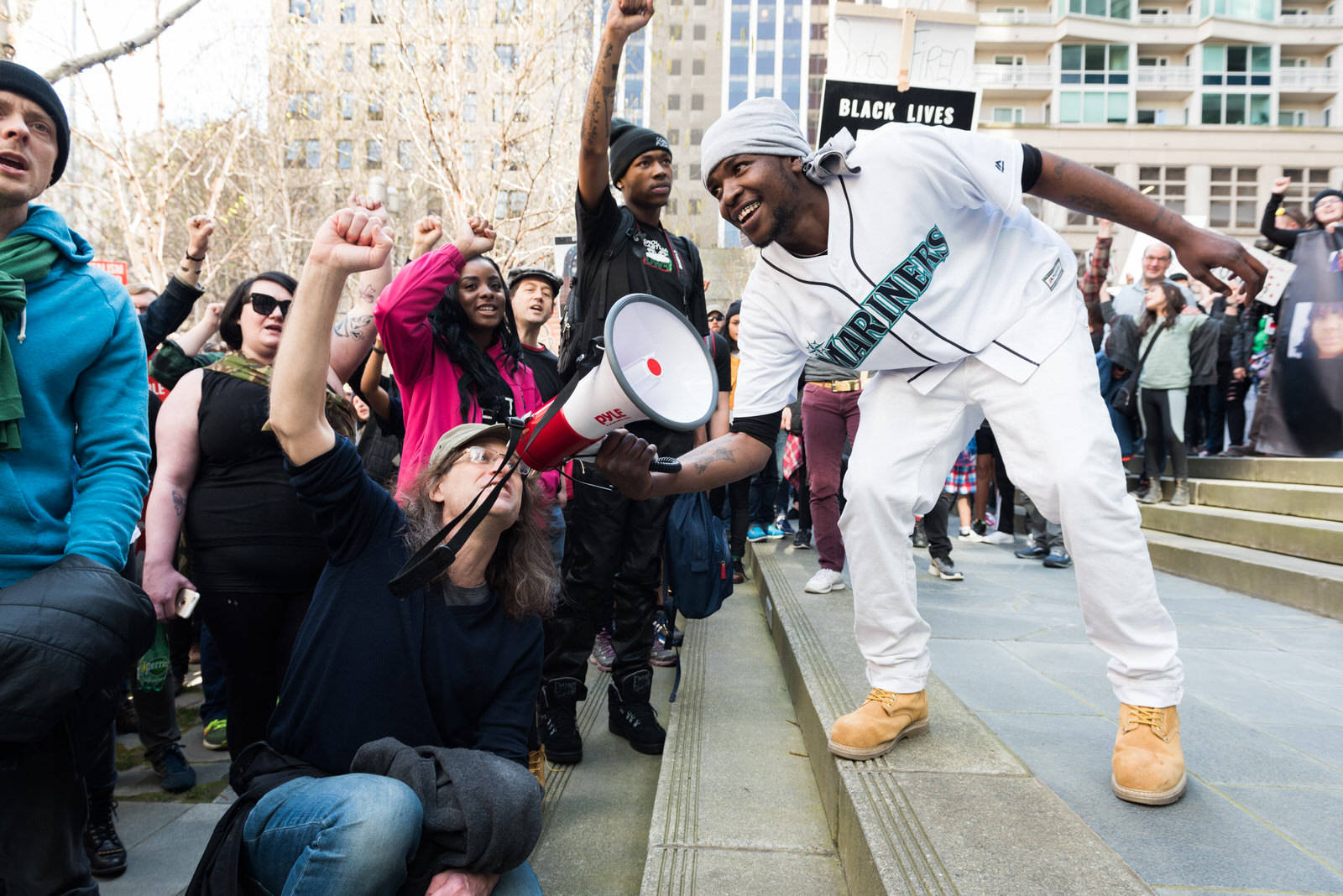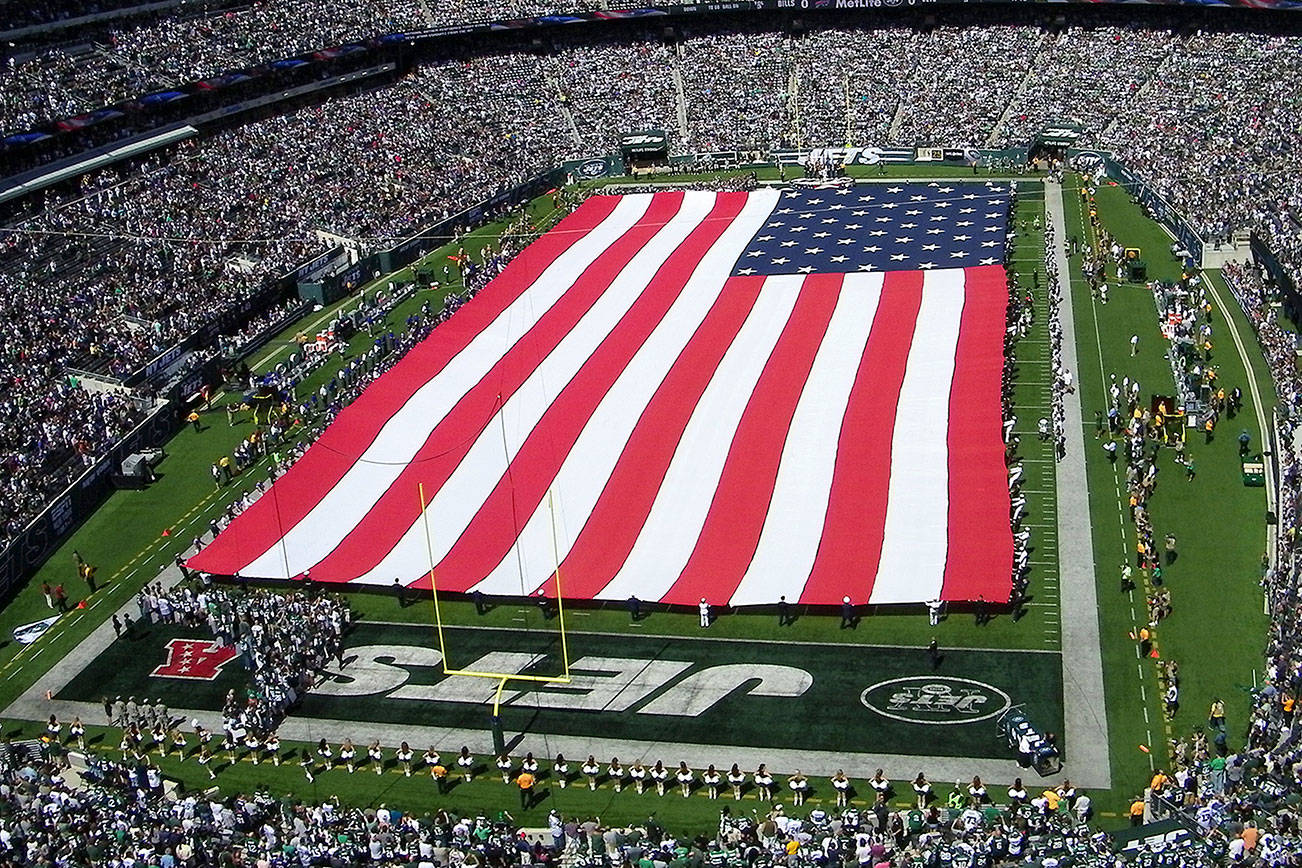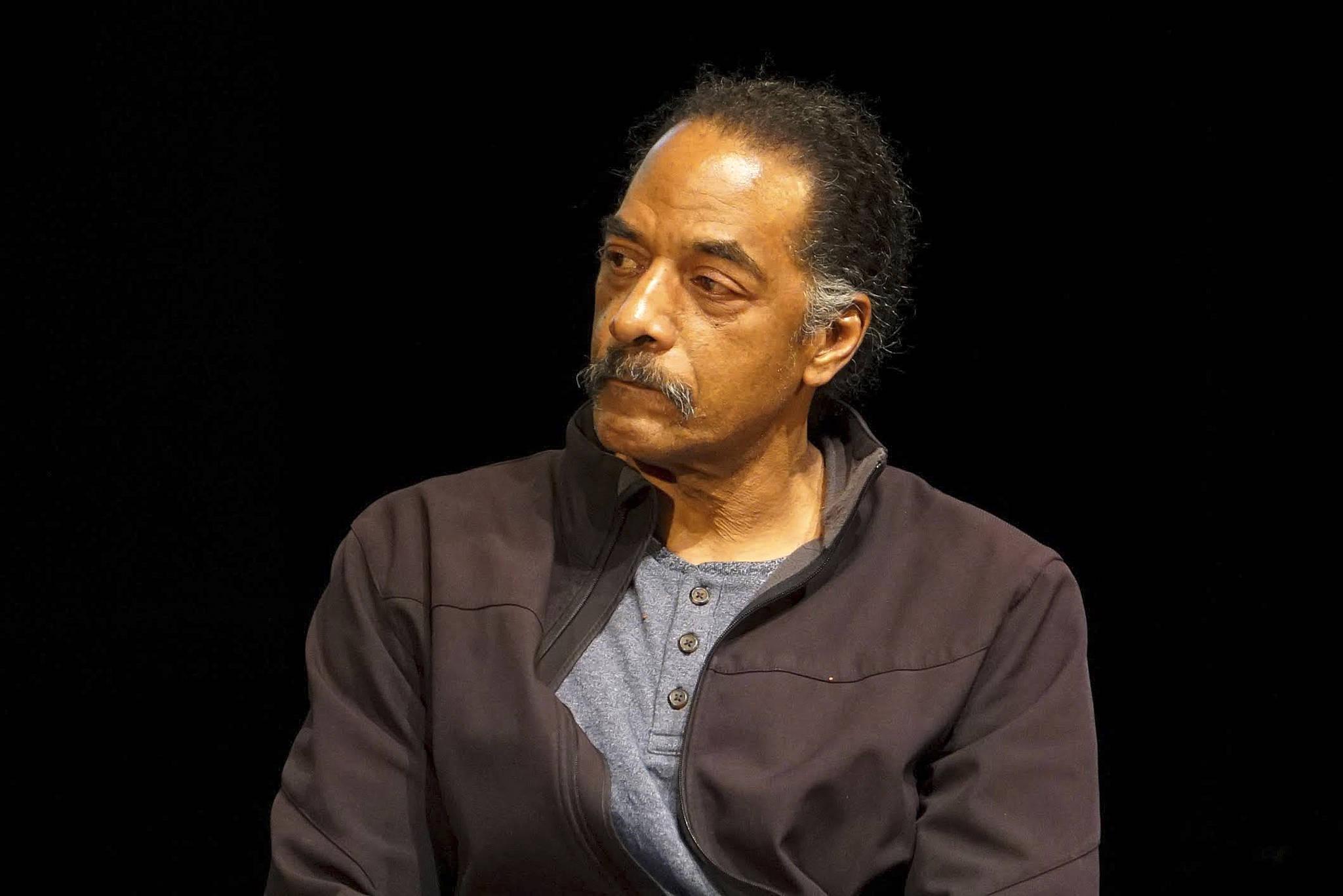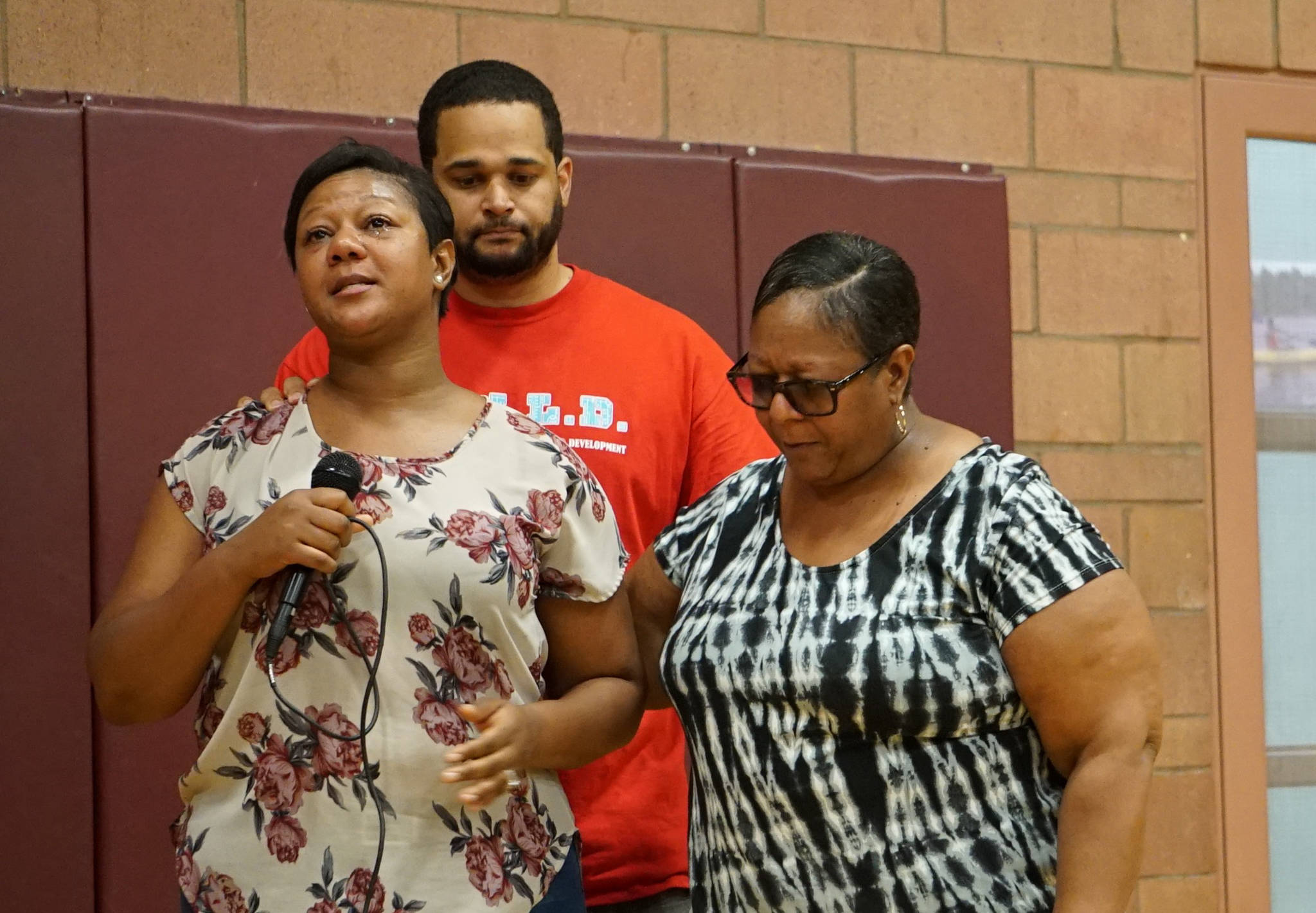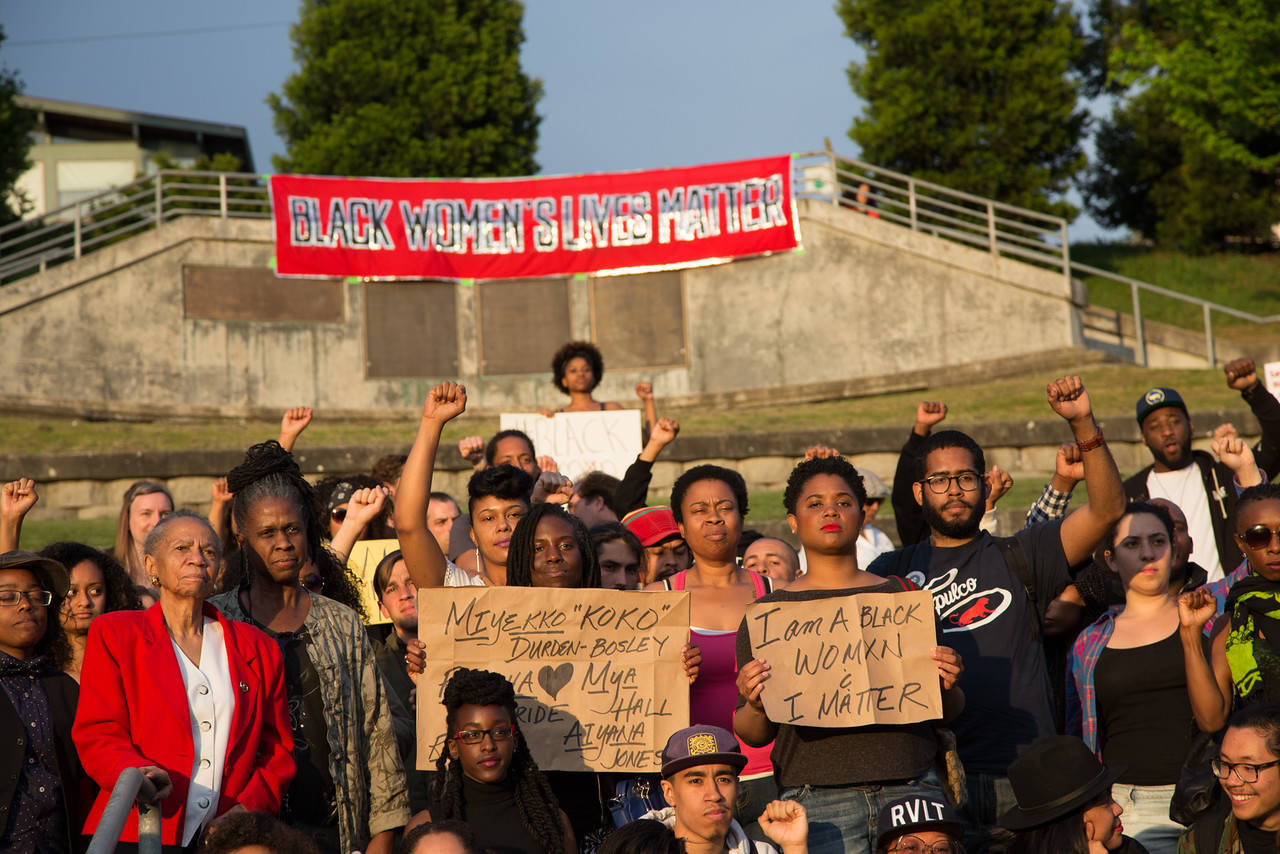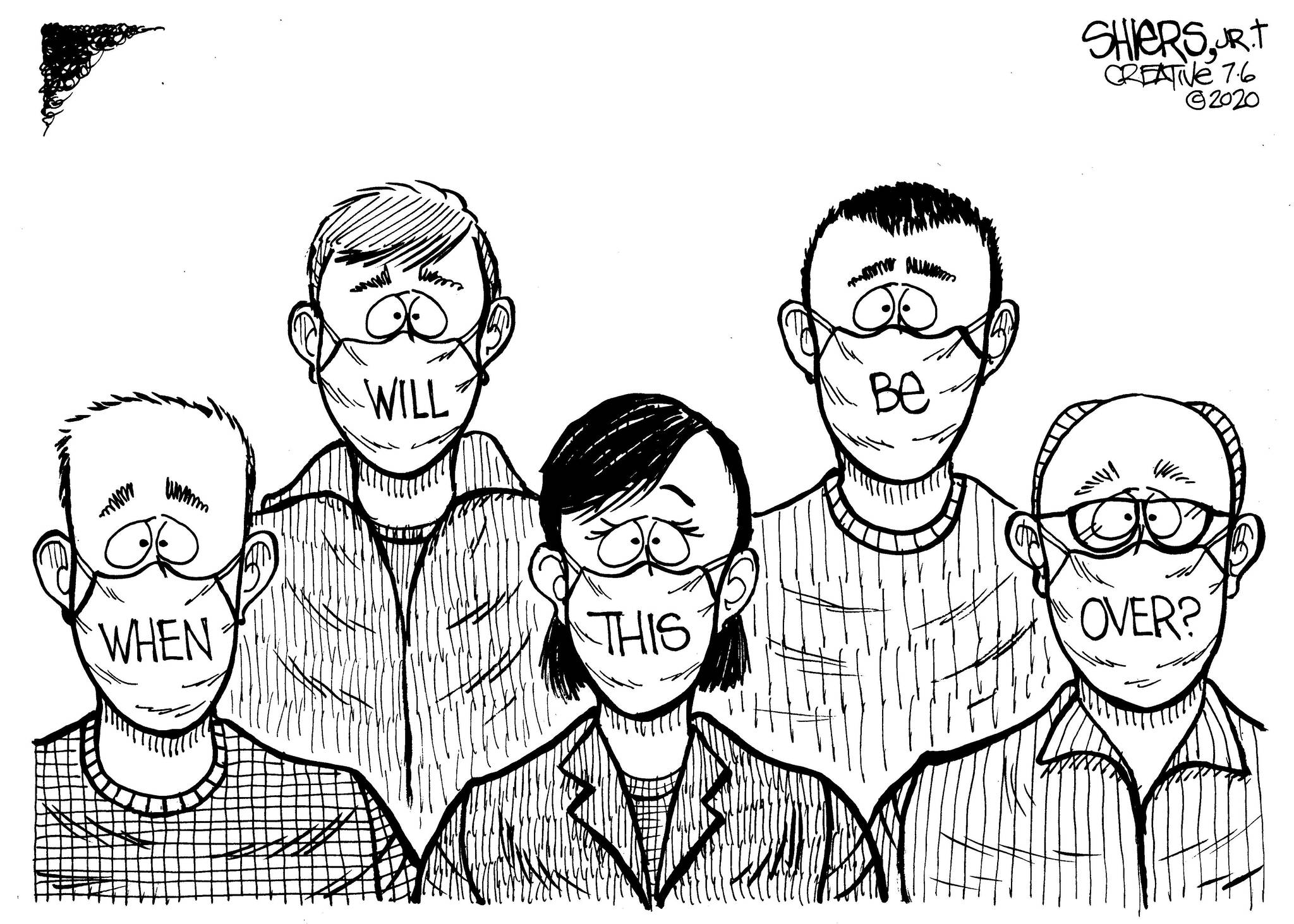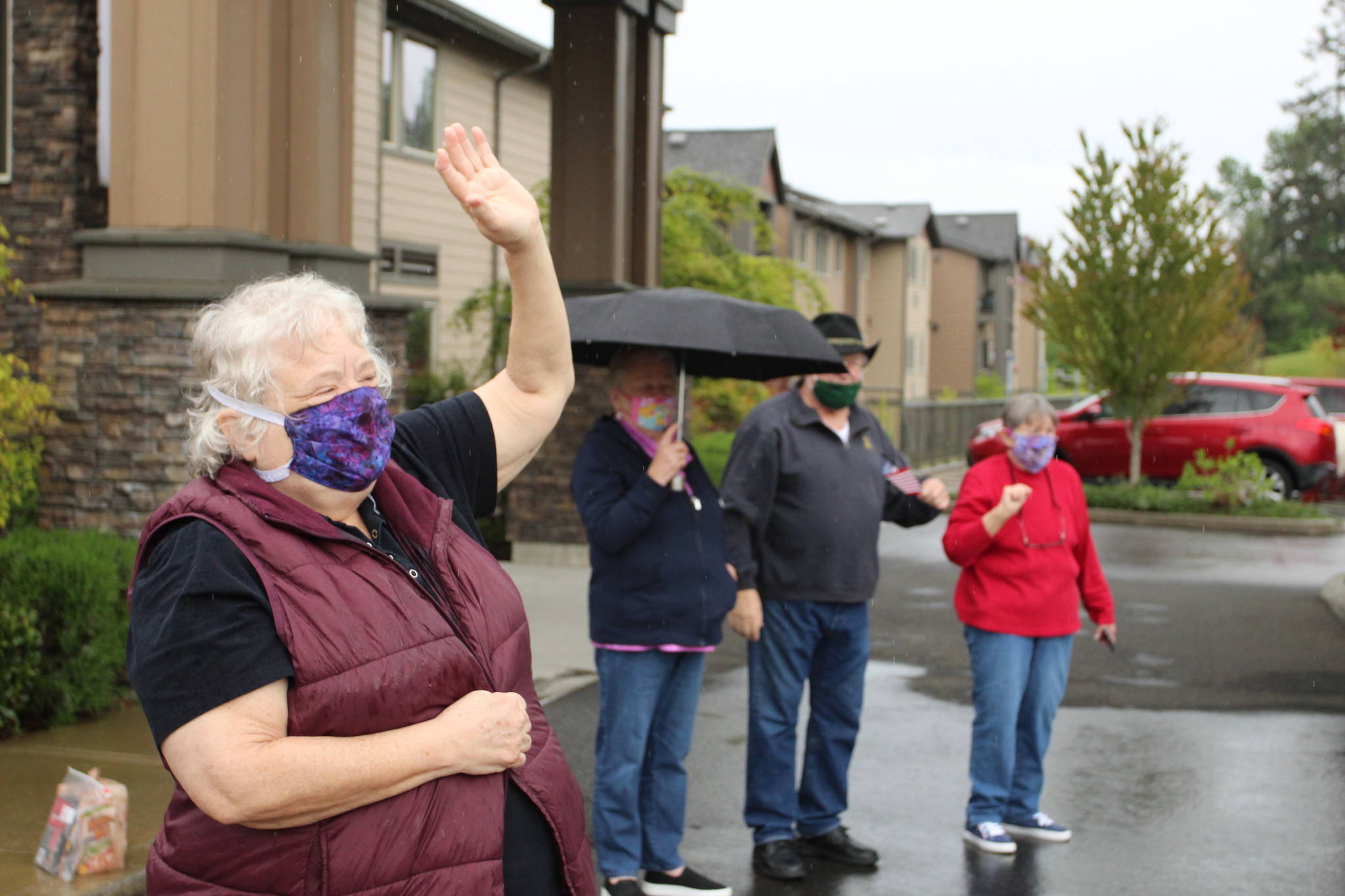The cries rang out in unison throughout Seattle’s Central District.
Black Lives Matter!!!
And as my own voice joined the chorus of hundreds of other marchers, one next to me gave a heavy sigh.
“You can’t go anywhere in Seattle without white people,” it said. “Seriously, why are all these white folks here?”
Treading through the CD, we scanned the crowd, taking in the proportion of black to white, feeling every bit the minority in a city two-thirds Caucasian. We were buoys of Hershey afloat in an ivory sea.
Just a year before, it was a different scene. At a march following the death of Eric Garner at the hands of the NYPD, the streets were filled with members of the city’s African-American community making a formidable public showing of solidarity against police violence. It was a galvanizing moment early in the Black Lives Matter movement. And, yes, smatterings of white allies were present, but they appeared in a supporting role.
In a very short time, the tide had turned toward crisp irony. Here was a BLM march with a majority of white participants ardently shouting about how much “Black Lives Mattered” in an area that “black life” had been forced to abandon due to high rents and low prospects.
That was almost two years ago, the catalyst for the march the deaths of nine congregants of Emanuel African Methodist Episcopal Church in Charleston, South Carolina. Those innocents had been slaughtered by Dylann Roof, a domestic terrorist who wore his white supremacy on his sleeve. And while of course these white marchers did not share Roof’s politics, and though they meant well, the overwhelming whiteness of the march inspired in me a deep cynicism that poisoned the well of communal warmth. I wondered how many of my white kinfolk were in attendance to simply build their personal brand, this event simply another addition to their “Social Justice CV,” along with #BLM Facebook profile pics, effusive Obama sycophancy, and platinum membership to the Ta-Nehisi Coates fan club, all accentuating how “not racist” they were.
Here were hundreds of them flooding past an area once 70 percent black, now less than one-fifth black and “85 percent Black Lives Matter placards” to quote a friend of mine.
That was the last time I deliberately pounded pavement at an organized Black Lives Matter march in Seattle.
I stopped covering BLM marches as a journalist, as well, having grown skeptical of their efficacy.
I do still scroll through the photos, tweet streams, and personal accounts, one blending into the next. What I see are more white faces and fewer black ones. In the past year it has become even more difficult to discern between a march for black lives and one meant to fight climate change or “Impeach Trump.”
At first blush, this development might be cause for jubilation. “Isn’t it glorious!” the conventional wisdom declares. “White people are woke and getting it in Seattle.”
But are they? And what are the impacts of Black Lives Matter marches where the black lives actually present are outnumbered by white lives.
Could this new dynamic actually be doing more harm than good?
Marchers take to the streets in the summer of 2016. Photo by Ted Zee
As organizer of the largest Black Lives Matter marches in Seattle since 2014, Mohawk Kuzma has had a front-row seat to the transforming demographics of the BLM movement. He says that my eyes are not deceiving me. There is a noticeable increase of white marchers, one that he says signifies that white Seattleites’ long hibernation on Black issues is at its end.
“The reason BLM marches are getting more white is because more white people are waking up and seeing the covert segregation and racial injustice and racism,” Kuzma tells me. “We see it on the news every day across the nation.”
He draws a connection with the overt displays of racism, from pervasive police killings of blacks to the recent domestic terrorist acts by white supremacists, most recently a school shooting by one in New Mexico.
Kuzma says that when he began organizing he welcomed whatever race, gender, or orientation felt compelled to attend, as long as the marchers understood “that all black lives matter and racial injustice, police brutality, and racism needed to stop.”
However, he also recognizes that the increased numbers of white folks is a double-edged sword.
“More white people also brings white ignorance and white fragility,” he says. “White people think they have to be respectful during a protest. Sorry, but we as black people don’t get respect from anyone, including white people, so why should we be respectful. We are here to get stuff done.”
According to artist, educator, and black community organizer Jerrell Davis, the issue of white people showing up to march is subordinate to what’s actually facing the black community: black survival. It is a very real concern in a city where more and more black residents are moving to Kent, Des Moines, and other areas of South King County.
“What does it actually mean?” he asks, repeating my question regarding the increasing participation of white Seattleites at BLM marches.
“Does it mean white folks here are more empathetic? Does it mean they’re more willing to go to a march they know will be protected by police?”
For Davis, more white marchers equates to an increased police presence at marches. The aura of safety reduces the risk of attending, he says, which leads to nothing more than a march serving as a symbolic act for white people ultimately leaving the racial status quo unchallenged.
“Honestly that shit doesn’t shift the culture of this city,” he concludes, his black lochs flowing from beneath his green cap.
Davis—who is becoming well known for his socially-conscious, movement-based hip-hop under the name Rell Be Free—has participated in numerous Black Lives Matter marches in Seattle and Philadelphia. And while he sees these marches as a necessity in the broader movement for Black liberation, and an entry point for previously disengaged white people to encounter movement politics, he says more energy needs to shift to the activity between marches.
“[Seattle has] a Race and Social Justice Initiative, but every week there are black people leaving this city because they can’t live here. We have a zero detention policy in place, but they’re still building a youth detention center. So what good is white people showing up on their own time, when black folks have little time left in this city?”
He views such policies as performative, much like the red, black, and green of the Pan-African flag that is painted on the crosswalks of the Central District. These measures commemorate a once-thriving community, but they do little to empower those who remain. He wonders if the same is happening when white perpetrators of gentrification march in the streets for black lives.
“It’s befuddling to me,” Davis says. “It’s as if some people march as some sort of social justice penance. But do those same people ever ask themselves, ‘You know … I’m knowingly moving to this place and it’s hurting people, so should I?’ ”
During this year’s tax day protests, Black Lives Matter activists came out in force. Photo by Ted Zee
Concurrent with a rise in white participation is an apparent decrease in the number of black people marching for black lives. It’s a shift that doesn’t surprise activist Amir Islam. He knows first-hand how exhausting it can be for displaced black folks to travel to Seattle marches.
“Some Black activists are burnt out from marches,” he says. “You have to think that a lot of the black community has been pushed out to Auburn, Kent, Des Moines, Puyallup even. … It’s hard enough to survive let alone get to your own people for a march.”
Islam says he gave up organizing Seattle-area marches about the time I stopped going. He says that marches are simply one thunderbolt in the gathering storm needed to ravage societal racism, and he has chosen to focus his energies on another approach: community development work.
He says he is fine with the increased white presence at Black Lives Matter marches, though he is uncertain of their effectiveness.
“Let white people rally, talk to other white folks, and march for the humanity of black people,” he says. “Truthfully, though, it’s not like they’re doing anything radical like buying up a block of homes to give back to the Duwamish.”
Anti-racist whites say they are listening to the concerns of black activists and trying to guard against transgressions while also keeping the door open to more white allies—something that activist Erica Sklar sees as a source of energy for the movement, but one with many potential pitfalls.
“It’s two sides to the same coin,” says Sklar, an organizer with Anti-racist organization CARW. “The reality of Seattle’s population means there’s more white folks and could mean more exposure, but white folks need a critical analysis of issues.”
That deep analysis includes a raw, unflinching assessment of the role racism has played in shaping our present, and where it has placed white people, relatively to non-whites, in this country.
Sklar, who served as a civilian peacekeeper at Seattle’s most recent May Day protest, says she has witnessed white people armed with good intentions but lacking crucial foundational recognition of the social justice movements they aim to serve.
“When you show up the first time [to a march], maybe you don’t know who you’re accountable to, but you should know by the end,” she says. “I think a majority of white folks come to this work with fervor but not a deep analysis. One of the deep tragedies of race in this country is white people are never told that they don’t belong somewhere. So they think they belong everywhere.”
Such a scenario played out last April when Black Lives Matter Philadelphia decided to host meetings free of white people so that their members could “come together to strategize, organize, heal, and fellowship without the threat of violence and co-optation.”
Cue the apoplectic white liberal fury (along with the expected alt-right trolling). Black people, working on black issues, outside of the white gaze for some reason elicited outrage.
It was a situation where black people were actually asking white people for support in the form of trust. Trust to organize and heal, free from prying oversight.
I’ve heard it myself many times: the white colleague with the gilded heart who just wants to know what they “can do,” unsatisfied with my taoist suggestion that “doing nothing” is at times more than enough.
“Sometimes, we as white people have to understand that support means leaving a space,” says Sklar.
Fellow white anti-racist organizer Carly Brook says the initial burning desire of many white people to attend a BLM march, particularly after a high-profile killing of a black person by law enforcement, is symptomatic of white folks being “socialized to attend to urgency,” without the necessary accountability to the movements they’re attempting to assist.
“Seattle has a culture of advocacy, but not organizing for advocates; we try to speak for each other,” explains Brook, who organizes with the Seattle chapter of white anti-racist group European Dissent as part of the People’s Institute for Survival and Beyond.
She says while she’s encouraged about white folks becoming increasingly aware of the acute systems of oppression that black folks face, she echoes Sklar’s concern about white people having deeper conversations about what they’re truly fighting for.
A show of solidarity during the April protest. Photo by Ted Zee
The stone cold truth is that in a city where a mayor’s race can be won without one single black vote, the social currency possessed by white folks is powerful. Yet, allies must walk a tight-rope between utilizing the privilege society has afforded to them and making sure they’re amplifying the work of people of color instead of overshadowing POC efforts. Here too, there is work to be done.
During a coffee meet-up, activist, musician, and organizer Gabriel Teodros told me about the times his anti-racism conversation has been met with curiosity, while that of the attendant white artist was met with moonstruck fascination.
“It’s a reality that when you go into a room with a group of white people, they aren’t going to pay attention to us in the same way they would another white person, even though we’re both saying the exact same thing,” says Teodros.
It seems like common sense, but must still be said: Only by listening to those who have a lived experience of oppression that white allies can understand what they are fighting for. But there is an important role for those white voices as well, says Sklar.
“The reality of Seattle’s population means that more white folks could mean more exposure for [anti-racist] issues,” says Sklar.
The best way to reach white people, after all, is through other white people. Just look at a couple recent surveys: Nationally, 91 percent of white people have social networks exclusively comprising other white people according to a poll by the Public Religion Research Institute, and 57 percent of whites believe “reverse-racism” is widespread. This is why European Dissent and CAR-W encouraged their members to discuss racism with their white family members during the holidays. It might make for awkward dinner conversation, but it is arguably more impactful than marching in the streets.
“It’s going to take a lot of holding people we disagree with close. We must keep imaging it’s possible. It’s going to take lifelong work,” Sklar says, adding that people must also engage in these discussions with co-workers, friends, and clergy members.
Those routine interactions are how societal transformations are nourished. For the black activists I spoke with the time to do so is yesterday. If marching in the streets helps get more white people out of their social bubble and engaged with black issues, then, so be it.
“The city is engaged in a conversation of who actually gets to live in the city,” says Teodros. “You and I are talking in Seattle today, but it could be Kent tomorrow if we aren’t doing the work every day to ensure this community stays here.”
In other words: start marching, then take further strides.
letters@seattleweekly.com
Marcus Harrison Green is the editor of the South Seattle Emerald. His column appears in The Weekly on the last Wednesday of every month.
